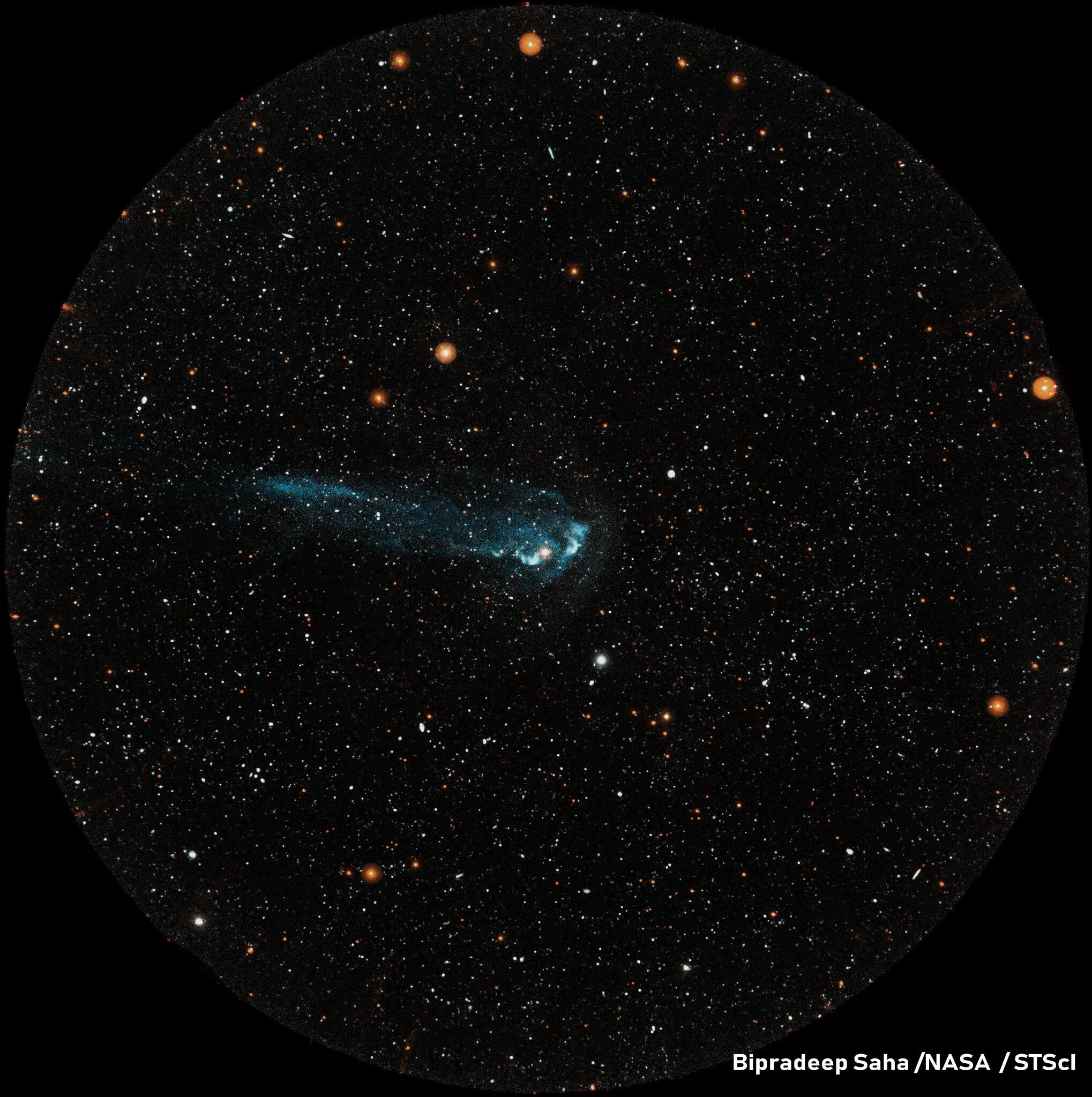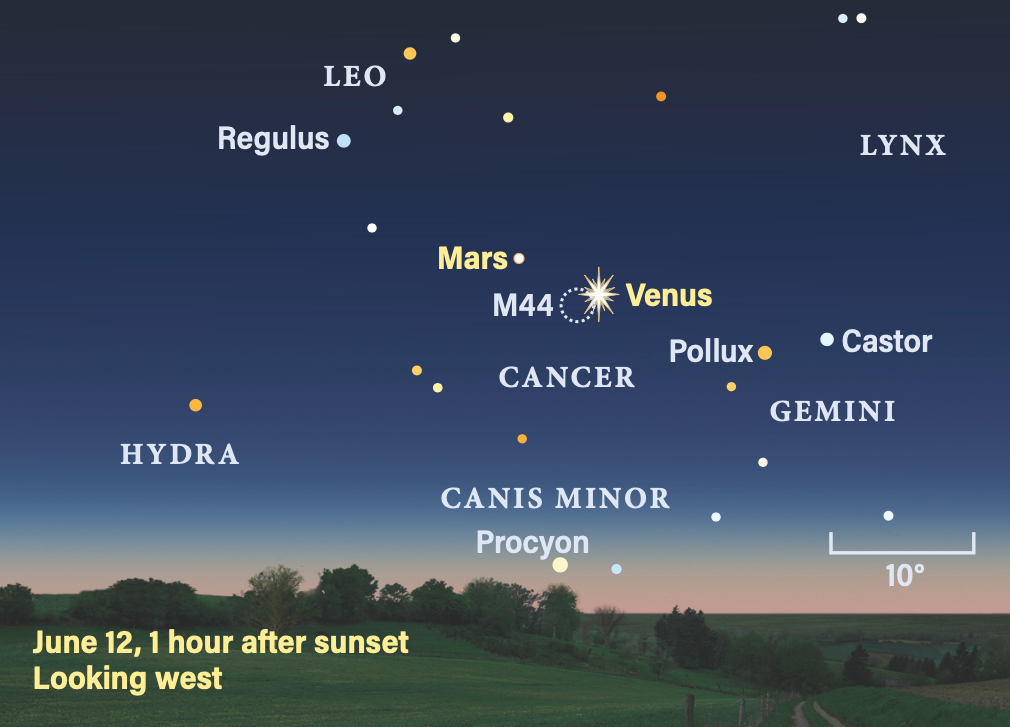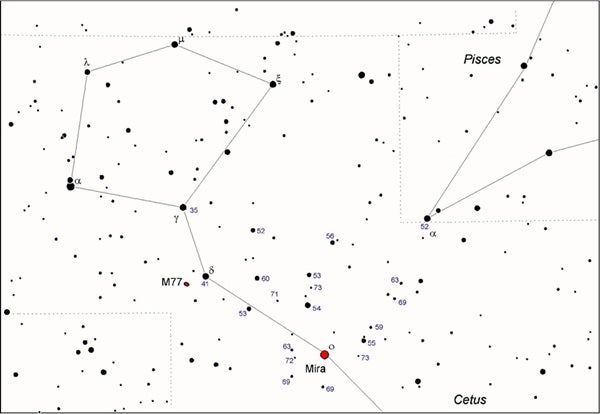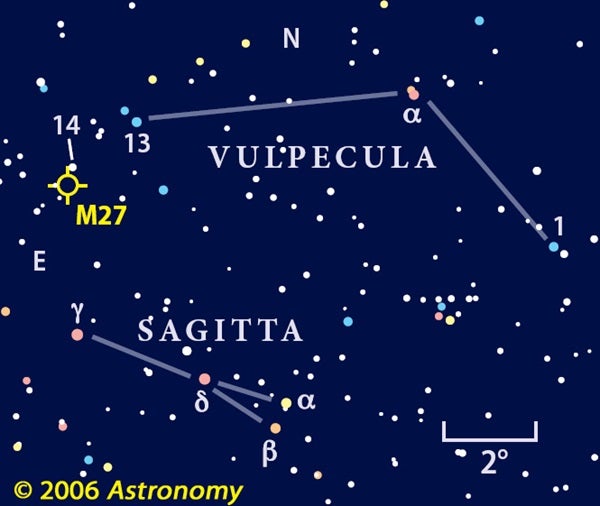
Friday, June 9
The Moon passes 3° south of Saturn at 4 P.M. EDT. The pair isn’t visible then — but you can catch them in the early morning tomorrow before sunrise, still sharing the constellation Aquarius.
With no Moon in the late-night sky, it’s the perfect opportunity to look for noctilucent clouds. Noctilucent means “night-glowing,” as these clouds appear bright in the sky overhead long after dark. In truth, it’s a trick of the curvature of Earth — because noctilucent clouds form high up in the atmosphere, they remain illuminated by the Sun long after it has sunk below the horizon from your point of view. They’re most visible north of latitude 55° in the late evening (around midnight or a little after) and can spread out in stunning displays that many people love to photograph. All you have to do is get up, go outside, and look north for spidery silver-white clouds that appear to glow after dark.
What creates these clouds in the first place? They’re formed when ice crystals grow around tiny dust particles high in the atmosphere — some 10 times higher than where average cirrus clouds sit.
Sunrise: 5:31 A.M.
Sunset: 8:28 P.M.
Moonrise: 12:55 A.M.
Moonset: 11:28 A.M.
Moon Phase: Waning gibbous (63%)
*Times for sunrise, sunset, moonrise, and moonset are given in local time from 40° N 90° W. The Moon’s illumination is given at 12 P.M. local time from the same location.
Saturday, June 10
Last Quarter Moon occurs at 3:31 P.M. EDT, though the Moon itself has set by that time. Instead, catch our satellite early in the morning as it floats in Aquarius about 7° east of magnitude 0.7 Saturn.
Still slightly more than half-lit before sunrise, Luna now shows off the large Mare Imbrium, bordered on the southeast by the mighty curve of the Apennine Mountains. To Imbrium’s southwest is the bright crater Copernicus, whose spidery rays spread out in all directions. Can you spot them, brighter than the surrounding terrain?
Saturn, meanwhile, is attended by a court of moons mostly arrayed to its west: From farthest to nearest are 10th-magnitude Dione, Tethys, and Rhea, as well as fainter Enceladus. Bright Titan, around magnitude 8.6, lies due east of the planet, some 2.5′ from its center. And magnitude 11 Iapetus lies due west of Saturn, even more distant than Titan — about 4.5′ away.
Titan will be by far the easiest moon to spot, while the Moon’s relatively bright light nearby may wash out the sky and hide the other satellites, particularly in smaller instruments.
Sunrise: 5:31 A.M.
Sunset: 8:28 P.M.
Moonrise: 1:24 A.M.
Moonset: 12:41 P.M.
Moon Phase: Waning gibbous (51%)
Sunday, June 11
The Moon moves from Aquarius into Pisces early this morning, shortly after passing 2° south of Neptune at 4 A.M. EDT.
The ice giant, which glows at magnitude 7.8, will require binoculars or a telescope to spot as it sits just north of the Moon. The bright background sky might make a sighting challenging — look for a “flat,” bluish-gray point that doesn’t quite look like a pinprick of light like the other stars.
But don’t spend all morning on one planet — over at Jupiter, which rises some 90 minutes before the Sun, there’s plenty going on, depending on your time zone and when you observe.
The gas giant rises on the East Coast with the shadow of Io placed nearly midway on the massive disk. Io itself is coming in for a transit, crossing in front of the planet starting around 3:30 A.M. EDT. In the Midwest, the planet rises with Io halfway across and two shadows crossing the cloud tops: Io’s in the west and Europa’s in the east. Io’s shadow disappears around 4:40 A.M. EDT, while the moon itself slips off the disk an hour later (now in daylight on the East Coast), just minutes before Europa sets out across Jupiter’s face around 4:50 A.M. CDT. Europa’s shadow disappears shortly before sunrise in the Midwest, while the moon moves slowly over the disk, leaving around 5:10 A.M. PDT, just before sunrise along the West Coast.
Note that as the moons are crossing, you may also glimpse the massive Great Red Spot as well, carried across the planet’s face by its less-than-10-hour rotation rate.
Sunrise: 5:31 A.M.
Sunset: 8:29 P.M.
Moonrise: 1:49 A.M.
Moonset: 1:52 P.M.
Moon Phase: Waning crescent (40%)

Monday, June 12
This evening, it’s Venus’ turn to stun near the glittering Beehive Cluster (M44). As soon as darkness falls, look west, where Earth’s sister planet is blazingly bright at magnitude –4.5 and still 20° high an hour after sunset. Venus now lies just northwest of M44, a large open cluster situated smack dab in the middle of Cancer the Crab. Spanning slightly more than 1.5°, this group of young stars is visible to the naked eye under good conditions — see if you can pick out any of its stars after dark. They glow together with a collective magnitude of 3.7, readily visible as a group to the naked eye.
You can bump up the view with a pair of binoculars or a low-powered scope — pay attention to Venus as well, whose 26″-wide disk is not quite half-lit, a 45-percent-illuminated crescent. Then swing your gaze less than 7° east to land on Mars. The Red Planet, which passed through the Beehive earlier this month, will continue east along the sky as the month progresses, passing from Cancer into Leo by the 20th, with Venus close behind. Under magnification, Mars’ magnitude 1.7 face is just 4″ across.
Venus will stay with the stars of the Beehive another night, so if you don’t get a chance to view it today — or simply want to come back for another look — it will lie just northeast of the cluster’s center tomorrow evening at the same time.
Sunrise: 5:31 A.M.
Sunset: 8:29 P.M.
Moonrise: 2:12 A.M.
Moonset: 3:01 P.M.
Moon Phase: Waning crescent (30%)

Tuesday, June 13
If you’re up just before the Sun this morning, you’ll easily find the delicate crescent Moon hanging above the eastern horizon about an hour before sunrise. Drop your gaze straight down and you’ll spot a star some 5° high — this is Mira (Omicron [ο] Ceti).
With a name that translates to wonderful, Mira has a lot going for it. In fact, it’s the eponymous Mira variable, a type of variable star whose brightness waxes and wanes over the course of roughly a year. An aging red giant star, Mira’s changes in brightness are coupled to pulsations that also change its temperature and the amount of light we receive at optical wavelengths. Mira is now at its brightest, visible to the naked eye for several months to come. It is roughly magnitude 2, readily noticeable in the brightening sky. At its dimmest, Mira can dip to somewhere around magnitude 9, requiring binoculars or a small telescope to locate and leaving a dark patch in the sky where it usually sits. According to the late Jim Kaler, Mira is the only named star that is not always visible to the naked eye!
Although it’s readily visible now, the growing twilight coupled with Mira’s current low altitude might make it a bit hard to find. It’s certainly worth a try, especially if your eastern horizon is clear, but don’t worry if you strike out — over the next few months, Mira will rise earlier and climb higher in the sky before sunrise each day. By late summer, observers with good skies should be able to more easily catch it with unaided eyes before sunrise, even though it will have faded a bit by then.
Sunrise: 5:31 A.M.
Sunset: 8:30 P.M.
Moonrise: 2:36 A.M.
Moonset: 4:09 P.M.
Moon Phase: Waning crescent (20%)
Wednesday, June 14
The Moon passes 1.5° north of Jupiter at 3 A.M. EDT. The two hang together in the early-morning sky several hours before dawn, already some 10° high around 4 A.M. local daylight time.
Both are located in Aries; to their lower left (east) is the Pleiades star cluster (M45). You can enjoy the pinprick lights of its brightest stars with the naked eye as they climb above the horizon. If you want, zoom in with binoculars or a low-powered scope — even your finder scope will do, as this nearby cluster appears quite spread out on the sky, covering an area roughly 110′ wide.
If you want to inspect Jupiter up close again, its four moons are arrayed alongside it: Ganymede sits alone to the west, while (from nearest to farthest) Io, Europa, and Callisto are to the east. The moons are sandwiched between two field stars: a 9th-magnitude star sits less than an arcminute west of Ganymede, while an 11th-magnitude star is about 3.5′ east of Callisto. Take care not to mistake these small points of light for moons.
About halfway between the Moon-Jupiter pair and the Pleiades is Uranus. The distant ice giant glows at a meager magnitude 5.9, just at the edge of naked-eye visibility (provided conditions are perfect). Binoculars or any scope will show it, located just 2.1° south of 4th-magnitude Delta (δ) Arietis in the far eastern portion of the Ram. The Moon, sliding quickly along the ecliptic day by day, will pass near Uranus in just over 24 hours.
Sunrise: 5:31 A.M.
Sunset: 8:30 P.M.
Moonrise: 3:01 A.M.
Moonset: 5:08 P.M.
Moon Phase: Waning crescent (12%)

Thursday, June 15
The Moon passes 2° north of Uranus at 6 A.M. EDT, in daylight on the East Coast but in morning twilight or deeper darkness before dawn in the western part of the country. Our satellite is now a delicate crescent just 8 percent lit, its western limb the only region left in sunlight as the lunar day comes to a close.
After sunset, note how the Summer Triangle is rising in the east, anchored by Deneb in Cygnus, Altair in Aquila, and Vega in Lyra. This large asterism covers a huge swath of sky and straddles the rich plane of the Milky Way. Within its boundaries lie many deep-sky objects to enjoy, including nebulae; star clusters; and dark, cold clouds of gas.
Tonight, let’s choose just one to explore: M27, also known as the Dumbbell Nebula. Located in Vulpecula, M27 is a planetary nebula created as an aging star sloughs off its outer layers, blowing them into space. Some planetary nebulae look like large, round bubbles, but M27 — as its name implies — has a bi-lobed appearance that is thinner in the center and thicker at either end, like an hourglass or dumbbell. Astronomers believe most differences in the appearance of planetary nebulae are largely an effect of our viewing angle.
You’ll find the Dumbbell just 3° due north of magnitude 3.5 Gamma (γ) Sagittae. Glowing at 7th magnitude, the nebula covers about 8′ by 5′ and can be seen in smaller scopes, but higher magnification and larger apertures will let you tease out more detail. Its central star is 13th magnitude, generally requiring an 8-incher or more to spot. Nonetheless, the glowing gas it produces is brighter and easier to see in smaller scopes, and M27 a stunning example of a planetary nebula you won’t want to miss.
Sunrise: 5:31 A.M.
Sunset: 8:30 P.M.
Moonrise: 3:30 A.M.
Moonset: 6:27 P.M.
Moon Phase: Waning crescent (6%)
Friday, June 16
Continuing along the ecliptic, the Moon passes 4° north of Mercury at 5 P.M. EDT. You can catch them earlier in the day, though the tiny planet will be hard to spot in the morning twilight, as it’s just 4° high half an hour before sunrise.
Fortunately, we’ve got two tricks up our sleeve. First, the planet’s bright magnitude (–0.7) helps it to stand out against the brightening sky. And second, the Moon’s location directly above it acts as a guidepost. Find the Moon — now just a 3-percent-lit crescent — above the eastern horizon before sunrise and drop your gaze about 5° down toward the ground. If you have a clear horizon, you may spot Mercury.
Through a telescope, the solar system’s innermost planet appears 6″ across and is some 77 percent lit, showing off a gibbous phase. If you do choose to observe Mercury through a telescope or binoculars, as always, make sure to put them away several minutes before sunrise from your location, which may differ from the times we give.
Sunrise: 5:31 A.M.
Sunset: 8:31 P.M.
Moonrise: 4:03 A.M.
Moonset: 7:34 P.M.
Moon Phase: Waning crescent (2%)

Sky This Week is brought to you in part by Celestron.









